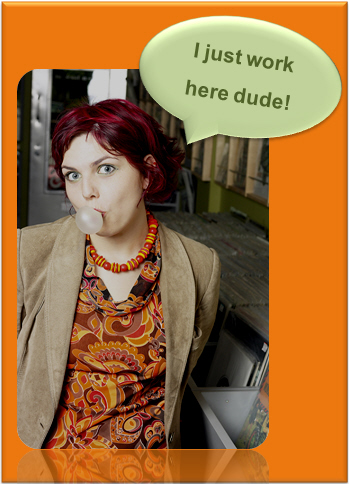" Customer service is a process of systems and personal interaction that makes the customer feel that their needs have been met."
If it was just a customer service definition you were after, then this definition has probably left you feeling a bit dry.
Why?
Because that's what 'definitions' are. They are clinical statements; the bare bones of the matter.
Customer service definition must now be re-written and the concept re-invented.
Why?
Because many folk have never experienced good customer service.
How do I know?
Let me tell you a true story.
I have lectured for many years in Customer Service from a retail sales perspective at Blacktown College of TAFE (in Sydney, Australia).
I begin my class discussion with the definition as you have it above and describe how 'good' customer service feels. I then ask
'Who has experienced good customer service like that?'
Not one person raises their hand.
That's sad.
Why sad? Well, all they have ever experienced is:
* Waiting in a queue (either in person or on a phone).
* Having to search for a staff member to point them where in the store to go to find what they wish to purchase.
* When they do engage with staff, it's usually met with the worn out "Can I help you?", and a tired facial expression that screams "Hurry up, I've got others to get to!"
They have never had the experience of somebody looking them in the eye and asking them about their REAL needs for the particular product or service.
They have never experienced a benefit focused demonstration of what they REALLY need.
All they have experienced is going and grabbing what they want and joining a queue to pay, before being released from the store's checkout.
But the internet is changing all this.
Customer service is becoming up front and personal.
Now, true one to one marketing is possible, using Google, Facebook, Twitter, email, the 3X3 System and carefully worded sms text messages.
Big companies have woken from their sleep and realised it costs five time as much money to get a new customer than to hang onto an existing one. Have you noticed the explosion of customer loyalty programmes lately?
A whole new level of Customer Service is emerging. What is it?
Delighting the customer.
But what is 'Delighting the Customer'?
May I continue with my classroom illustration?
I go on to describe 5 levels of Customer Service to the students:
1. The bottom level is no service at all.
It is what is experienced in most large department stores (Myer, Walmart, Macy's, Sears, Debenhams, Harrods, House of Fraser and Fortnam and Mason to name a few).
I illustrate this by asking the class to close their eyes and imagine they are standing in the centre of the sales floor of a department store with a rifle.
 Now they may raise the weapon to their eye and begin to turn in a circle (slowly) and if they happen to find a staff member who comes inside their sights, they are allowed to pull the trigger. [Laughter usually ensues at this point].
Now they may raise the weapon to their eye and begin to turn in a circle (slowly) and if they happen to find a staff member who comes inside their sights, they are allowed to pull the trigger. [Laughter usually ensues at this point].
Why do they laugh? Well they all know that they probably will never shoot a staff member - because there are none to be seen.
This is the bottom level of Customer Service. None at all.
2. The next level up is Bad Customer Service.
This is usually experienced by having someone grunting at you or saying
"You right?" and pointing you to where you get what you need
and then the 'finger' points you to the next torture - the checkout. You are met with a loud "Next!" (even if you are the only person there). Your money is taken and you are expected to exit the store as quickly as possible so they can 'process' other poor creatures.
3. Adeuqate Customer Service.
This is when you are greeted with "How may I  assist you today?" and the person actually stays with you through the whole process. They listen then launch off to 'go fetch' what they think they know you want (usually with you trailing behind) and answer any questions you have (often on the run). They may escort you to the checkout where another person in a flat voice, asks the state of your health (with no obvious intention of wanting a reply). Your money is taken. You are even proffered a 'Thank You', before leaving.
assist you today?" and the person actually stays with you through the whole process. They listen then launch off to 'go fetch' what they think they know you want (usually with you trailing behind) and answer any questions you have (often on the run). They may escort you to the checkout where another person in a flat voice, asks the state of your health (with no obvious intention of wanting a reply). Your money is taken. You are even proffered a 'Thank You', before leaving.
4. Good Customer Service.
This, by the way used to be what business strived for [it is now outdated and 'delighting of the customer' is the new benchmark].
Good Customer Service begins with a friendly greeting from someone who puts aside what they were doing and who engages good eye contact. They ask to be of assistance then ask more descrete probing questions to determine your REAL need, what competitor's offers you have been noticing and what your budget is.
They then demonstrate the features of the product or service, applying each feature to your expressed needs as a benefit.
They then ask you to buy (probably not as directly as that!).
This level of service is being discovered by many smaller speciality stores and Business to Business suppliers as the way to not only keep good customers but to get them to buy more.
What is missing?
At the 'Good Customer Service' level, nobody has understood the importance of getting the customer to do these three important things:
a. Return another time to buy again, and
b. Have the customer so thrilled about dealing with their firm that they can't help but tell their neighbours, relatives and Facebook friends about how they were treated. Or finally
c. were they asked for a testimonial of how they felt when doing business with you
These are the keys to 'Delighting the Customer'.
5. Delighting the Customer.
What does it take to Delight a Customer? What produces that WOW experience?
 a. Listening. REALLY taking the time and effort to hear what your customers think about you. You may have to ask them in a quick survey. It's an eyeopener - and not always a happy one. [I have developed a Quick Client Satisfaction Survey' I do with businesses - email me here and I'll arrange one for you].
a. Listening. REALLY taking the time and effort to hear what your customers think about you. You may have to ask them in a quick survey. It's an eyeopener - and not always a happy one. [I have developed a Quick Client Satisfaction Survey' I do with businesses - email me here and I'll arrange one for you].
b. Develop a policy of ALWAYS asking "How will our customers feel about this change" when making changes to any of your systems (I mean ALL of them: accounting; purchasing; staffing; training; delivery; hours of business; all customer interaction policies [like complaints, privacy and all client contact] or web site).
How will the customer feel about this change? Will it delight them?
c. Timing is everything. Delighting the customer begins after the sale is finished. Yep. You heard me right. Anything extra you can do for the customer that elicits the response:
"Oh, you didn't have to do that! Thank you"
That's what you want to hear. That produces Raving Fans for your business.
d. Personal contact - for their benefit only. You must get their email address and send them helpful hints & tips; care and instruction details; ways for them to save money or use their product better. Make them feel they are part of your 'inner circle' - they feel like one of your 'preferred clients'. Never use these points of contact as ways to sell them something else or appear to have an ulterior motive for your contact.
e. Be transparent. Everybody 'connects' with businesses who admit when they have made a mistake, apologise for it and fix it straight away. Even offer them something for the inconvenience, like Sean DeSousa of Psychotactics did when his website got hacked and went down for the weekend recently. He gave away a special report - just to say sorry.
Because the consumer's expectation of customer service has been eroded by so much bad customer service it's not hard to impress.
Make every customer contact matter.
If you enjoy the way I put things. If it puts a smile on your face. Why not get my FREE Updates:

Paul Johnson
https://www.missingpiecemarketing.com.au/blog/how-to-keep-clients/77-customer-service-definition
p.s.If you are in the service industry you may enjoy these two other reports:
'Do you immunise every new client of yours' others have.
Or even:








